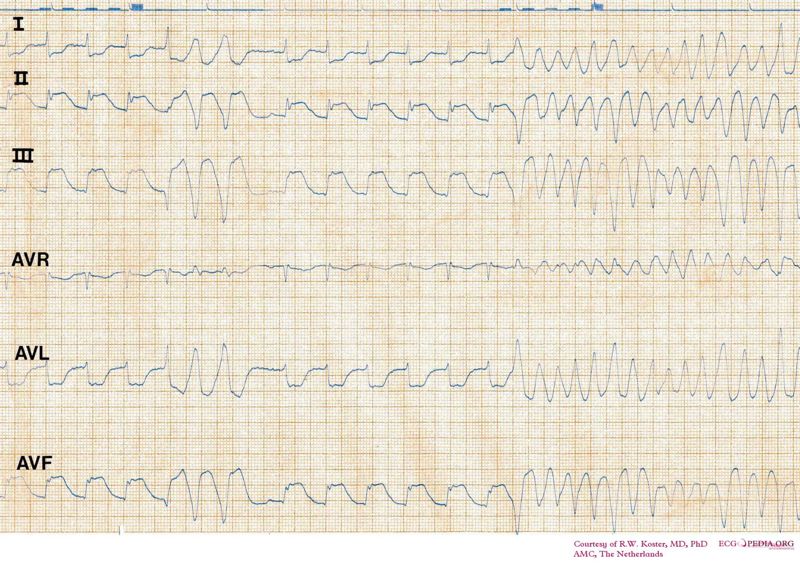Ventricular fibrillation EKG examples: Difference between revisions
No edit summary |
No edit summary |
||
| Line 9: | Line 9: | ||
Shown below is an EKG image of ventricular fibrillation showing irregular heart rhythm, [[heart rate]] of more than 300 per minute, QRS duration unrecognizable and absent P waves. | Shown below is an EKG image of ventricular fibrillation showing irregular heart rhythm, [[heart rate]] of more than 300 per minute, QRS duration unrecognizable and absent P waves. | ||
[[Image:Lead II rhythm generated ventricular fibrilation VF.jpg|500px|center | [[Image:Lead II rhythm generated ventricular fibrilation VF.jpg|500px| center]] | ||
---- | ---- | ||
| Line 16: | Line 16: | ||
[[Image:Vwivfklein.jpg|500px|center | [[Image:Vwivfklein.jpg|500px|center]] | ||
---- | ---- | ||
| Line 29: | Line 29: | ||
[[Image:De-ECG_SR_to_VF_in_INF_MI.jpg|center|500px]] | [[Image:De-ECG_SR_to_VF_in_INF_MI.jpg|center|500px]] | ||
---- | |||
Shown below three panels are continuous and represent the testing of a Medronic model 7219 defibrillator. The channels are a surface EKG lead, a ventricular intra-cardiac recording and a marker channel from the device. | |||
The first panel shows rapid paced ventricular beats followed by a low energy shock which induces VF. The shock is not on the T wave. | |||
[[Image:Ventricular fibrillation.jpg|center|500px]] | |||
==Sources== | ==Sources== | ||
(Copyleft images obtained courtesy of ECGpedia, http://en.ecgpedia.org/index.php?title=Special:NewFiles&offset=&limit=500) | (Copyleft images obtained courtesy of ECGpedia, http://en.ecgpedia.org/index.php?title=Special:NewFiles&offset=&limit=500) | ||
Revision as of 19:50, 15 October 2012
Editor-In-Chief: C. Michael Gibson, M.S., M.D. [1]
For the main page on Ventricular fibrillation, click here
Ventricular fibrillation EKG examples
Shown below is an EKG image of ventricular fibrillation showing irregular heart rhythm, heart rate of more than 300 per minute, QRS duration unrecognizable and absent P waves.

Shown below is an EKG image of ventricular fibrillation showing irregular heart rhythm, heart rate of more than 300 per minute, QRS duration unrecognizable and absent P waves.

Shown below is an EKG image of ventricular fibrillation showing irregular heart rhythm, heart rate of more than 300 per minute, QRS duration unrecognizable and absent P waves.

Shown below is an example of sinus rhythm converting into ventricular fibrillation wave pattern of irregular rhythm and unrecognizable QRS and P waves.

Shown below three panels are continuous and represent the testing of a Medronic model 7219 defibrillator. The channels are a surface EKG lead, a ventricular intra-cardiac recording and a marker channel from the device.
The first panel shows rapid paced ventricular beats followed by a low energy shock which induces VF. The shock is not on the T wave.

Sources
(Copyleft images obtained courtesy of ECGpedia, http://en.ecgpedia.org/index.php?title=Special:NewFiles&offset=&limit=500)